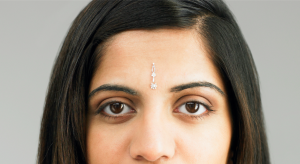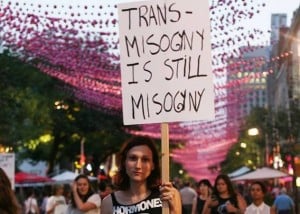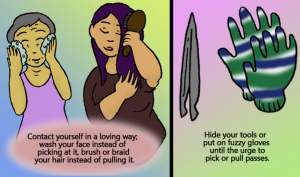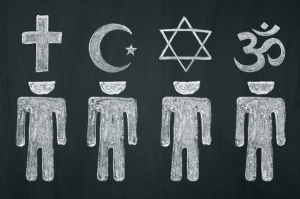
A green freeway sign pointing to “true” in one direction and “false” in the other. Source: Women Vote PA
Close your eyes and think about the word abortion.
What are some of the first things that come to mind?
Pregnancy? Unborn fetuses? Policy makers? Crying? Grief?
I’m guessing at least one of these probably popped into your head.
Our society is filled with all kinds of mixed messages and myths about abortion. We often frame the conversations around abortion as being defined by grief and pain, instead of a personal decision that is filled with a plethora of emotions and experiences.
Although abortion can involve grief and sorrow, not all people who get abortions do experience these emotions, and that’s perfectly okay.
There is no right or wrong way to navigate having an abortion.
Because of the amount of emphasis the larger cultural conversations have in these myths, it’s important that we talk about them. These myths have real consequences and real effects on policy, which limits people’s right to choose.
Let’s bust some of these myths.
Myth #1: Abortion is baby-killing.
This is something you’ve probably heard a lot.
The fact is that a fetus is not a baby. A fetus is a developing mammal; in humans, a fetus develops at the end of the second month of gestation.
A baby, on the other hand, is a human offspring who has already been born.
It’s important to understand that there is a difference: development.
A zygote (a fertilized egg) that has implanted in the uterus just two days ago is not the same thing as a human life that has already come into being.
In terms of the person housing the pregnancy, this difference is important: a fetus cannot survive without its parent during gestation—there is no separation. A baby, on the other hand, is an autonomous being.
Therefore, a fetus is a part of the person housing the pregnancy. For a mother, that makes its existence a part of her, making it her choice to terminate; hers, and hers only.
And the talk about fetal pain? That’s just phony science.
This logically leads to the conclusion that a baby and a fetus are not the same things. A baby can survive without using its mother as a life-source; a fetus cannot.
When you have an abortion, you aren’t taking the life of an autonomous being, like in cases of infanticide. Rather, you are removing a part of your own body.
Myth #2: Abortion is used as a form of birth control.
I’m sure you’ve heard people say something to the effect of “I believe in choice, but I also don’t think it’s okay to use abortion as birth control.”
Using abortion in place of contraception is not something people (okay, most people) do!
From a logical standpoint, this idea doesn’t even make sense, as it assumes abortion is easier to access than contraception.
Abortion is becomingly increasingly hard to access and requires a lot of money and time to get. The average cost of abortion is $451 in the first trimester, but can cost upwards of $3,500.
And this doesn’t even include transportation costs, co-pays and premiums, a possible hotel-stay (as many states have mandatory waiting periods), nor the cost of possibly needing to take time off of work to fulfill the waiting period requirements.
A study conducted by the Guttmacher Institute found that 31% of women who live in rural areas traveled more than 100 miles to receive abortion services, and 74% traveled more than 50 miles to access services.
This data, the most recent on record, is from 2008 (let’s not even talk about how depressing that is), before many of the most harsh restrictions on abortion services were put into place.
Also, only 66% of health insurance providers cover abortion services to some degree, which makes paying for an abortion very difficult. Michigan just passed a law banning the use of private health insurance for abortion services, joining eight other states with laws like this already on the books.
Additionally, the Hyde Amendment restricts federal dollars from going to fund abortion services, meaning that the poorest Americans often cannot get funding for abortions.
The average person using abortion as contraception would become pregnant two to three times per year, and would therefore be getting two to three abortions per year. This would extremely difficult to manage and doesn’t align with statistics detailing who gets abortions.
58% are in their twenties, 69% are economically disadvantaged, and 61% have children. Not exactly ideal candidates to shell out thousands of dollars a couple of times each year.
Typically, obtaining contraception is going to be a lot easier than this.
Not to mention the fact that half of the people who get abortions reported using contraception during the month they became pregnant.
Myth #3: People who have abortions regret it or experience intense grief.
There’s no shortage of propaganda out there that shows people grieving after terminating their pregnancy. There’s a lot of hype around “post-abortion syndrome” and its negative effects — which have been proven to not exist.
This myth dominates a lot of ideas about abortion: that it’s emotionally turbulent, is chosen by emotionally unstable people, and usually results in regret.
The truth is that most people do not regret their abortions. In fact, almost 75% indicated that the benefits of getting an abortion outweighed the harm.
Another study found that 95% of abortion patients felt that they’d made the right choice.
The rates of reported depression are equal to those of the general population, not indicating anything disproportionate.
Grief and sadness are not bad emotions to feel after getting an abortion.
But neither are they the only, or even the most common experiences people have after having them.
Myth #4: Only selfish women have abortions.
This myth is built in sexism. Women who in some way choose to remain childless are constantly portrayed as being self-centered and uncaring.
A good example of this from the media would be Samantha from Sex and the City. She’s very open about the fact that she doesn’t want children, but is also portrayed as being very reckless and stoic.
Getting an abortion is not a selfish decision.
People attribute abortion to selfishness, because women are expected to put themselves last (in relation to other people) and to always take on the role of nurturer and caregiver.
This myth exists because of the ways that society has constructed womanhood: women are valued primarily for their beauty and for their roles as mothers.
Those who choose to remain childless are choosing themselves; this is in direct conflict with a culture where women are supposed to always be selfless.
There are a lot of factors that go into deciding to terminate a pregnancy; it’s not an easy decision.
Most people who get abortions are young and/or low-income, meaning that they probably aren’t ready or in the best position to take on parenthood. Often, abortion patients cite age and income as among the reasons they chose abortion:
“I had an abortion when I had just turned 16. I came from a poverty-stricken, dysfunctional family and honestly didn’t know how easily one could become pregnant. I knew bringing a baby into the world I was living in would not be fair. The child would have grown up as poor as I was, would live in a dysfunctional family just as I was, and would have little hope for a future. I feel that I made the best decision a mother could for a baby,” Lori writes.
The decision of if, when, and how to have children is completely yours to make.
Myth #5: If abortion becomes illegal, abortion will end.
The foundation of anti-choice activism and legislation assumes that, if abortion is criminalized, abortions will no longer be performed.
This assumption couldn’t be further from the truth.
Global research has shown that making abortion illegal doesn’t decrease the rate of abortions. The only thing it changes is the safety of the procedure.
When abortion is illegal, it is unsafe.
13% of maternal deaths worldwide are abortion-related (that’s 47,000 women) and almost all of them happen in places where abortion is illegal.
When abortion is criminalized it only creates unsafe conditions and results in more deaths. It does not prevent abortion from taking place.
It serves no one.
The key to ending abortion is to create more access to contraceptives and sex education.
Myth #6: Only women get abortions.
Abortion rhetoric is highly gendered. Rarely is it even acknowledged that abortion patients are not exclusively cis women.
The dialogue around abortion is so gendered in fact, that it completely erases trans people.
There are plenty of trans men who need access to abortion and who receive them. There are also plenty of other trans folk who don’t fall into the gender binary who also get abortions.
The fact that abortion is so often framed from a privileged perspective means that those who are marginalized in other ways are not being heard and their stories aren’t seen as important.
We must recognize the cissexism within reproductive rights activism and stand with trans people.
***
These myths don’t even scratch the surface of all of the problematic framing of the abortion conversation in our culture.
There is a lot of work to be done in advancing this conversation. It seems the battle for reproductive rights will never be fully won.
But the more we steer the conversation toward human rights, feminism, and body politics, the more clearly this issue is shown, rather than being bombarded with propaganda and a fear-based mentality.
Here’s to protecting our right to choose, one myth-busting at a time.
[do_widget id=”text-101″]
Erin McKelle is an e-activist, video blogger, student, and non-profit advocate who has launched several projects, including Fearless Feminism and Consent is Sexy. In her spare time, Erin enjoys reading, writing bad poetry, drawing, politics and reality TV. You can visit her site here find her blogging at Fearless Feminism, Facts About Feminism, and Period Positive. Follow her on Twitter @ErinMckelle and read her articles here.
Search our 3000+ articles!
Read our articles about:
Our online racial justice training
Used by hundreds of universities, non-profits, and businesses.
Click to learn more




















